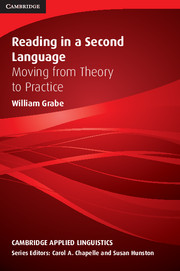IV - EXPANDING READING COMPREHENSION SKILLS
Published online by Cambridge University Press: 05 August 2012
Summary
In Part III, Chapters 10–13 described the core skills that comprise reading comprehension. These include the development of main-idea comprehension, reading strategies, grammar knowledge, discourse knowledge, and vocabulary knowledge. Part III also presented many specific implications for instruction to help build these core skills and knowledge bases. In Part IV, Chapters 14–17 will extend the discussion of these core skills and knowledge resources by introducing the following themes for expanding comprehension skills: the development of reading fluency skills, the importance of engaging in extensive reading, the power of curricular and instructional practices to improve reading, and the potential of assessment practices to support student learning (a theme not commonly associated with assessment practices).
Chapter 14 addresses the topic of fluency in reading, a topic that is gaining increasing attention as a key aspect of reading abilities. In L1 reading contexts, oral passage-reading fluency has demonstrated a strong relationship with reading comprehension. In experimental training research, fluency is a strong predictor of comprehension development. These two findings have led to a much greater awareness of the role of fluency as a type of component skill. Over the past 10 years, since the report of the National Reading Panel (2000), a considerable amount of new research has appeared on reading fluency. In L2 contexts, relatively little fluency research has been carried out and fluency is not yet a major element of reading instruction. This chapter also provides an extensive discussion of fluency-instruction practices as well as guidelines for their implementation.
Chapter 15 extends the concept of fluency, and reinforces the core skills introduced in Part III, through a commitment to extensive reading.
- Type
- Chapter
- Information
- Reading in a Second LanguageMoving from Theory to Practice, pp. 287 - 288Publisher: Cambridge University PressPrint publication year: 2008

